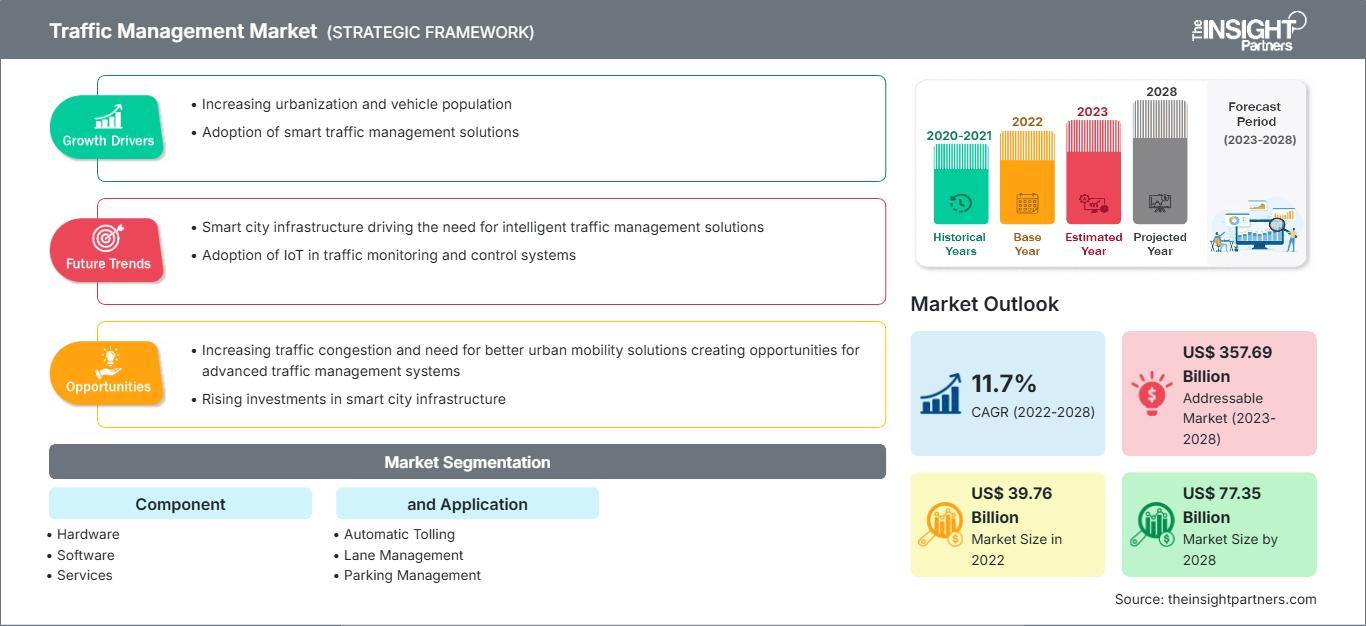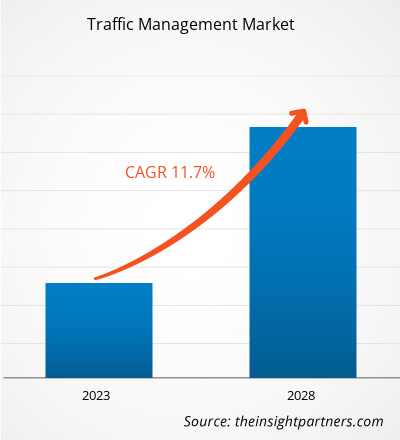交通管理市場は、2022年の397億5,674万米ドルから2028年には773億4,644万米ドルに達すると予測されており、2022年から2028年にかけて11.7%のCAGRで成長すると見込まれています。
多くの国では、長年にわたり急激な都市化が進み、道路網が複雑化し、渋滞が深刻化しています。都市人口の増加と自家用車の所有台数の増加が相まって、道路上の車両数が増加しています。インドのムンバイの人口は、2011年の1,850万人から2020年には2,040万人に増加し、自家用車の台数もこの期間中にほぼ倍増しました。このような要因と、それらを改善するために、交通管理市場の成長が予測されています。さらに、Uber、Grab、Ola、Lyftなどのタクシーアグリゲーターによる配車サービスが急速に増加しています。これらのサービスは大量輸送システムを代替し、道路上の車両の急増につながっています。これらの要因により、政府当局は効果的なソリューションを求めて交通管理市場のプレーヤーにアプローチせざるを得なくなりました。交通渋滞は、ソフトウェア、センサー、カメラ、表示板で構成される堅牢な交通管理システムによって効果的に軽減できます。これらのシステムは、インフラを変更することなく既存の道路に設置できます。同様に、車線管理システムは、各時点の交通量に応じて車線を開閉することで、交通の流れを効果的に管理できます。交通管理システムが提供する利点を考慮すると、急速な都市化の速度は交通管理市場規模を大幅に押し上げると予想されます。
交通管理市場の成長に対するCOVID-19パンデミックの影響
COVID-19の発生は、自動車、製造、エネルギー・電力、航空宇宙・防衛などの産業垂直市場に混乱をもたらしました。 2020年には、防衛、建設などの分野で大きな打撃を受けました。COVID患者数の継続的な増加により、米国およびその他の国の政府当局は、2020年の最初の3四半期に厳格なロックダウンを実施せざるを得ませんでした。これにより、すべての国で輸送が大幅に減少しました。貿易禁止、渡航制限、労働力制限などの封じ込め措置の実施は、交通管理ハードウェア、ソフトウェア、およびサービスを提供する企業を含むさまざまな企業の製造、供給、販売活動に影響を及ぼしました。製造部門は、一時的な工場の閉鎖と生産量の減少により深刻な損失を被り、交通管理ハードウェアシステムの生産も妨げられました。米国では、連邦政府と州政府がパンデミックへの取り組みに重点を置いたため、交通管理ハードウェアとソフトウェアの導入が一時的に保留されました。欧州の交通管理業界は、インフラプロジェクト支出が約20%減少したために大きな打撃を受け、いくつかのスマートシティおよびスマート道路プロジェクトの遅延と中止につながりました。半導体価格の上昇とサプライチェーンの混乱が状況をさらに悪化させました。しかし、交通管理市場は2020年第4四半期にプラス成長を経験し始めました。
要件に合わせてレポートをカスタマイズ
レポートの一部、国レベルの分析、Excelデータパックなどを含め、スタートアップ&大学向けに特別オファーや割引もご利用いただけます(無償)
交通管理市場: 戦略的洞察

- このレポートの主要な市場動向を入手してください。この無料サンプルには、市場動向から見積もりや予測に至るまでのデータ分析が含まれます。
レポートの一部、国レベルの分析、Excelデータパックなどを含め、スタートアップ&大学向けに特別オファーや割引もご利用いただけます(無償)
交通管理市場: 戦略的洞察

- このレポートの主要な市場動向を入手してください。この無料サンプルには、市場動向から見積もりや予測に至るまでのデータ分析が含まれます。
市場分析 - 交通管理市場
世界中でコネクテッドデバイスのブームが起こっており、多くの国がスマートシティの開発に投資しています。スマートシティとは、様々なセンサーや電子的手法を用いてデータを収集し、地域改善のために活用する、技術的に高度な都市圏のことです。スマートシティは、交通と物流の最適化、渋滞緩和など、交通管理に関する長期計画に基づいて設計されています。そのため、各国はスマートシティに加え、より安全な交通アクセスを提供するためのスマート道路の開発にも投資しています。スマート道路では、様々な種類のセンサーとハードウェアが多変量データを収集し、交通状況の監視に活用します。このデータは道路を走行する車両と共有できるため、ドライバーや通勤者は情報に基づいた意思決定を行うことができます。したがって、スマートシティとスマート道路の導入拡大は、交通管理市場規模の拡大につながると予想されます。
コンポーネントベースの分析
交通管理市場は、コンポーネント、アプリケーション、地域に基づいてセグメント化されています。市場は、コンポーネント別に、ハードウェア、ソフトウェア、サービスの3つに分類されています。ハードウェア市場はさらにカメラ、ディスプレイボード、センサーに、ソフトウェア市場はクラウドとオンプレミスに分かれています。様々な政府機関が、交通管理ハードウェアのアップグレードに投資しています。都市化の進展と自動車所有率の増加は、都市部の道路に負担をかけています。そのため、当局は交通流の維持管理を改善し、安全を確保するために、最新のカメラを活用しています。自動ナンバープレート認識(ANPR)カメラは、違反者の特定や事故調査中の車両の位置特定にますます導入されています。これらのカメラは、車両の速度を測定するために、レーザーセンサーと組み合わせて使用されることがよくあります。
用途別に、交通管理市場は、自動料金徴収、車線管理、駐車管理、監視、交通信号管理、その他に分類されています。地域別に見ると、市場は主に北米、ヨーロッパ、アジア太平洋(APAC)、中東・アフリカ(MEA)、南米(SAM)に区分されています。IBM Corporation、Cisco Systems, Inc.、Siemens AG、交通管理市場の主要プレーヤーとしては、杭州ハイクビジョンデジタルテクノロジー株式会社、Dahua Technology株式会社などが挙げられます。
交通管理市場の地域別分析
予測期間を通じて交通管理市場に影響を与える地域的な傾向と要因については、The Insight Partnersのアナリストが詳細に解説しています。このセクションでは、北米、ヨーロッパ、アジア太平洋、中東・アフリカ、中南米における交通管理市場のセグメントと地域についても解説しています。
交通管理市場レポートの範囲
| レポート属性 | 詳細 |
|---|---|
| の市場規模 2022 | US$ 39.76 Billion |
| 市場規模別 2028 | US$ 77.35 Billion |
| 世界的なCAGR (2022 - 2028) | 11.7% |
| 過去データ | 2020-2021 |
| 予測期間 | 2023-2028 |
| 対象セグメント |
By コンポーネント
|
| 対象地域と国 | 北米
|
| 市場リーダーと主要企業の概要 |
|
交通管理市場のプレーヤー密度:ビジネスダイナミクスへの影響を理解する
交通管理市場は、消費者の嗜好の変化、技術の進歩、製品メリットへの認知度の高まりといった要因によるエンドユーザーの需要増加に牽引され、急速に成長しています。需要の増加に伴い、企業は提供内容の拡充、消費者ニーズへの対応のための革新、そして新たなトレンドの活用を進めており、これが市場の成長をさらに加速させています。

- 入手 交通管理市場 主要プレーヤーの概要
交通管理市場のプレーヤーは、高度で効率的な製品の開発に主に注力しています。
- 2021年、Dahua Technologyは、現代の交通執行部門の多様なニーズを満たすために、ビデオ監視とAI、ANPR、画像融合、ARなどの最先端技術を組み合わせて開発された包括的なスマート交通管理ソリューションの開発を発表しました。
- 2021年、カメラ専門のIoTソリューションプロバイダーであるHikvisionは、道路の安全性と交通の流れを改善することを目的とした最新の交通製品であるAll-Rounder ITSカメラを発表しました。このカメラは、速度検知、交通違反検知、自動ナンバープレート識別、車両属性分析など、さまざまな機能と能力を1つのパッケージに統合しました。
- 過去2年間の分析、基準年、CAGRによる予測(7年間)
- PEST分析とSWOT分析
- 市場規模価値/数量 - 世界、地域、国
- 業界と競争環境
- Excel データセット
最新レポート
関連レポート
お客様の声
購入理由
- 情報に基づいた意思決定
- 市場動向の理解
- 競合分析
- 顧客インサイト
- 市場予測
- リスク軽減
- 戦略計画
- 投資の正当性
- 新興市場の特定
- マーケティング戦略の強化
- 業務効率の向上
- 規制動向への対応




















 無料サンプルを入手 - 交通管理市場
無料サンプルを入手 - 交通管理市場